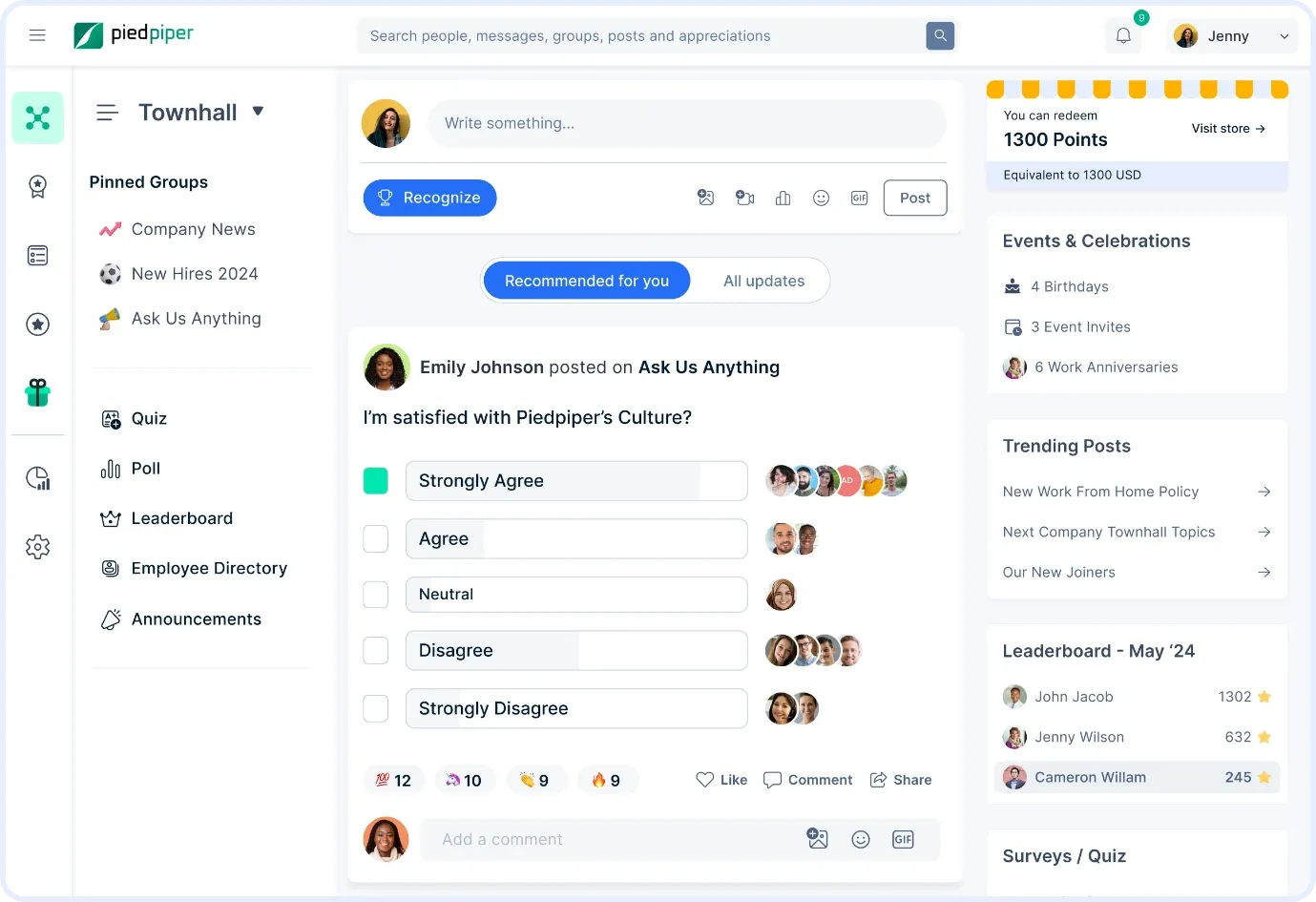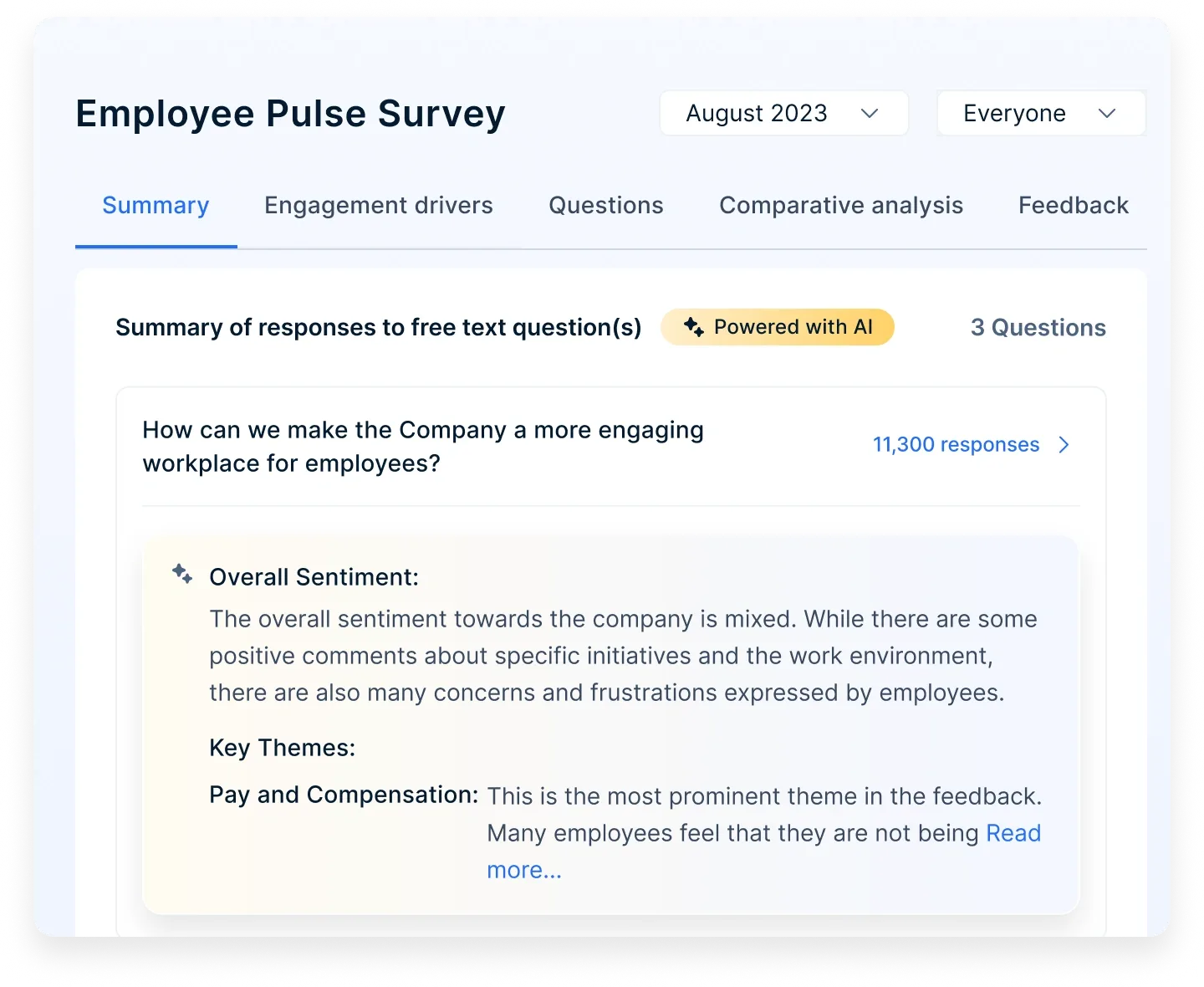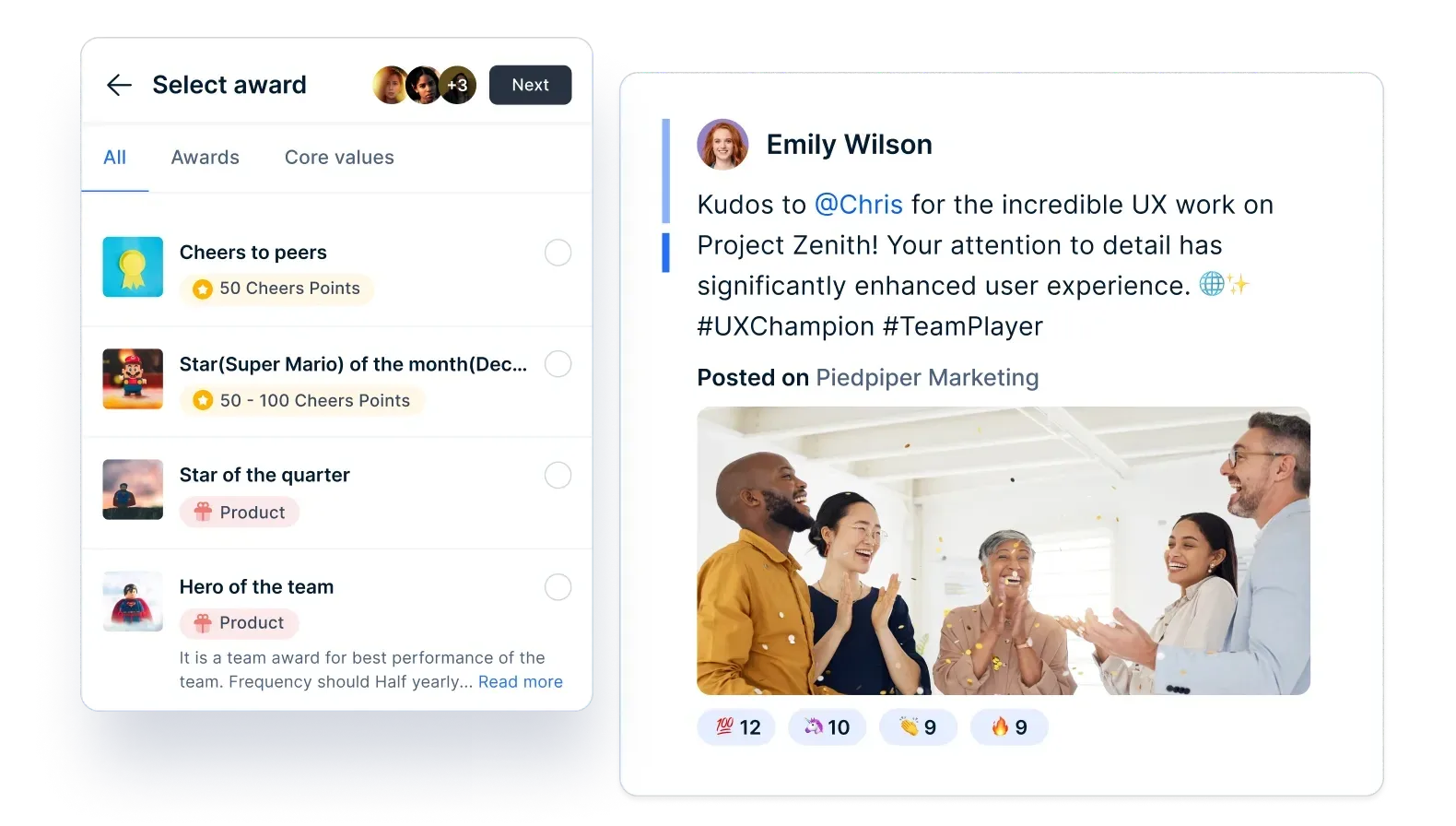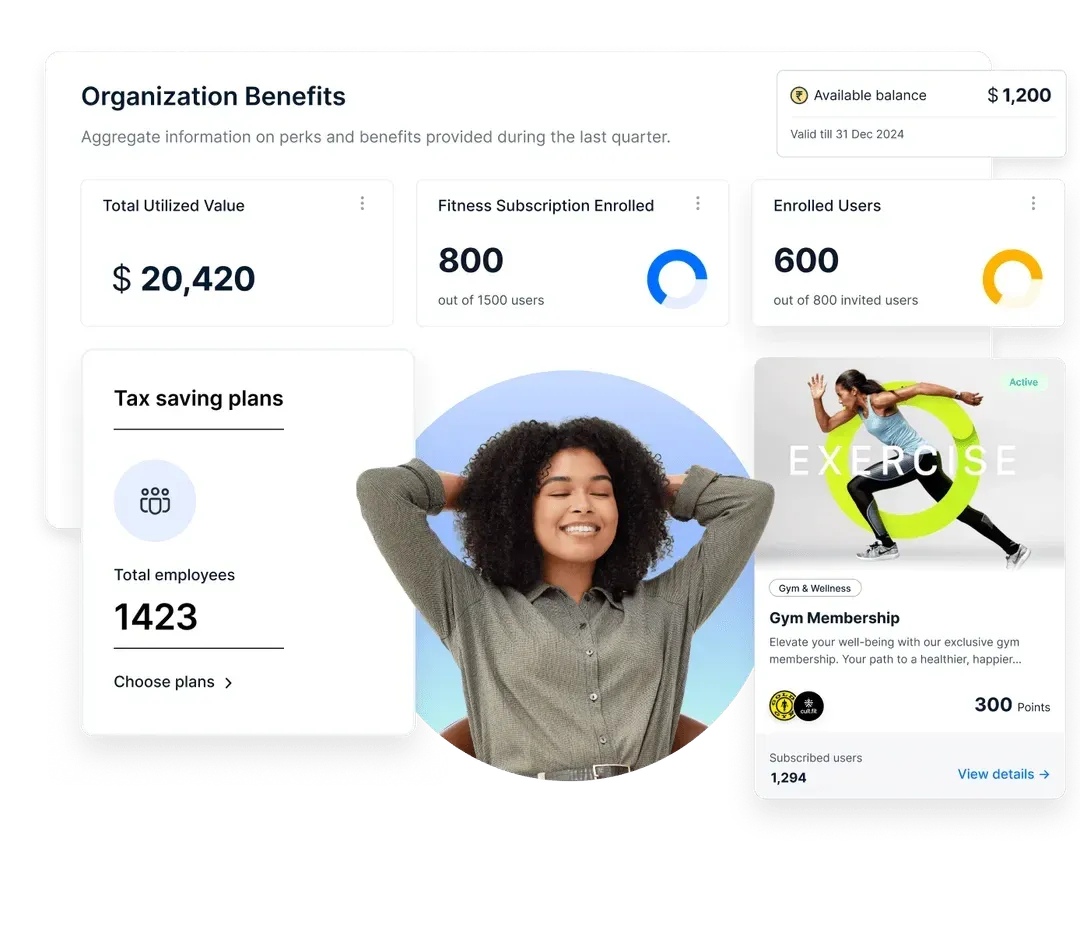How to Measure Employee Happiness: Proven Strategies, Methods and Tools
Learn how to measure employee happiness using surveys, feedback, and engagement strategies. Explore actionable tips to build a happy and high-performing workforce.
On this page
Today employee happiness has become more than just a feel-good concept—it’s a crucial driver of organizational success. Businesses that prioritize happiness in the workplace consistently report better performance, higher retention, and increased innovation.
But here's the challenge: while companies understand its importance, many still struggle with how to measure employee happiness effectively and implement actionable improvements.
With workplace happiness influencing everything from engagement to productivity, it’s time to decode what truly makes employees happy and explore proven strategies to both measure employee happiness and nurture it sustainably.
In this guide, we will walk you through measuring employee happiness, using tools like employee happiness surveys and the employee happiness index, and show how organizations can turn these insights into meaningful change.
What is employee happiness?
Employee happiness denotes an overall satisfaction and coincidence of expectations from work with actual perception.
Employees' happiness lies at the intersection of involvement and satisfaction. This is a quality of employee experience that is higher than employee satisfaction. It is one of the building blocks for attracting employees. Let's look at this question in more detail!
Satisfied employees 😌 perform well in their roles and have few complaints, but they can still explore other opportunities if presented with the options. The employees involved, in turn, regularly do more in their tasks than is usually required. They personally invest in the development of the company.
Loyalty to the business of such employees is very high. To reach this level, the organization needs the happiness of employees.
Employee happiness vs. job satisfaction
Employee happiness has tended to be talked about much less than job satisfaction in the business world. Therefore, there might be some confusion between these terms.
Besides, a comparable rarity of the term 'employee happiness' makes it seem like something difficult or impossible to achieve. However, this is not quite true.
First things first, let's draw a line between job satisfaction and employee happiness once and for all.
Employee happiness is often described as a constant positive attitude towards one's work. Besides, employee happiness also finds its representation in a strong motivation to solve problems rather than complain, willingly accept constructive criticism and improve one's knowledge and skills.
Satisfaction, as it is, means fulfillment and enjoyment a person drives from something. Job satisfaction, in its turn, is a measure of employee contentment with the job. This implies that the employees are satisfied at work as the work meets the expectations.
Key distinctive features between these two notions are quite obvious; however, they are often misunderstood by employers:
- Satisfaction is always a result of something fulfilled - a completed task or an achieved milestone. In contrast, happiness is a more permanent state which evolves gradually.
- It appears that employee job satisfaction is mainly controlled by the employer as it largely depends on rewards, recognition, and work-life balance. While employee happiness depends on employees themselves.
- Studies proved that happy employees are 13% more productive. At the same time, there is very little correlation between job satisfaction and productivity;
- Happiness at work is always a broader notion that encompasses being full of energy, engaged, committed, and, more importantly, satisfied.
There are hundreds of numbers in many longs, thoroughly documented reports that try to synthesize the most practical and concrete side of employee happiness and engagement. However, there are no black and white definitions here.
Despite the ambiguity of the terms, companies and employers can clarify the situation by collecting and combining human behavioral sciences that can shed more light on the “why” and “how” happiness works for their employees in particular.
Ways to create happiness in the workplace
Make your employees, sales, channels, networks, and extended teams happy with these three powerful strategies.
1. Motivate both externally and internally
‘Happiness Advantage’ author Shawn Achor describes happiness as “the joy we feel when striving for our potential.” This is squarely the preserve of intrinsic motivation - the inner impulses, talents, and passions that define our personalities and push us to chase targets that are often deeply personal.
Autonomy (the freedom to think-work-be), mastery over a domain or skill one is passionate about, and an overarching purpose or direction in life are the three primary intrinsic motivations in most humans.
Intrinsic goals usually act as their rewards, so to speak, and we pursue them purely for the satisfaction they bring us, without caring too much about ‘what others think’. Research has shown us how intrinsic motives can be a whopping 3X more impactful on employee engagement levels than than extrinsic motives.
This makes these ‘self-driven triggers to achieve high levels of excellence’ a highly potent and largely unexplored tool for a business when it has to up the ante and takes leaps into unknown territories with no precedence or benchmark for guidance.
Wise leaders allow the ‘room’ individuals to take those leaps. They align their workplaces and incentive models to ensure the maximum possible overlap between the individual’s intrinsic drivers and the larger business goals to fuel the latter.
According to a McKinsey study, intrinsically motivated employees exhibit 46% higher levels of job satisfaction and 32% greater levels of commitment to their jobs.
That said, there’s no getting away from the fact that good old-fashioned money continues to ‘buy happiness’ daily for the majority of us. External (extrinsic) motivations such as cash, social esteem, and materialistic indulgences - remain evergreen drivers of ‘profitable’ behavior and the favorite go-to devices for leaders to invoke and incentivize people's power.
↠ 46% of upper management in large-scale companies deems that incentive programs are an investment and not an expense.
↠ McLean & Company found that a disengaged employee costs an organization approximately $3,400 for every $10,000 in annual salary.
2. Reward instantly and memorably
Annual revenue increases are three times higher in teams with a measurable incentive system over counterparts without a similar motivational model.
There’s an ancient saying, “Pay the worker his dues before his sweat has dried up.” Mankind has known for ages that the joy of a reward is greatest when it exchanges hands quickly. The longer the delay, the more is lost–especially from the giver's perspective.
Morale flags, momentum dwindles, disgruntlement sets in. Leaders are left with precious little to show for all the excellent work done in training, engaging, and incentivizing. The reverse is equally true.
↠ According to The Economic Times, 88% of employees want employers to reward them for great work.
↠ According to the same study, 47% of employees want to receive a personalized reward spontaneously.
↠ According to Think Smart, companies with incentive programs registered a 79% success rate when it comes to reaching goals when the correct reward was offered.
↠ According to Incentive Research Foundation (IRF), an intuitively incentive program has been proven to raise employee performance by up to 44%.
Ensuring that your rewards are instant, commensurate (that is, measures up to the magnitude of the achievement), and personalized (resonates with the persona and wish-list of the recipient) can be a simple and powerful hack to get the best out of employees.
3. Design a connected workplace
The spirited criss-cross of small talk and vital feedback. The free-flowing exchange of ideas and tips. The intuitive nudge and alerts from peers. The doors and windows of gratitude shared discreetly and publicly turn the workday warmly rewarding.
Employees, channels, and extended teams evangelize the brand on social media. The stickiness of loyal workers translates to low team attrition. The ‘people stories’ that go viral create an ‘Awesome Place To Work’ type of buzz. The reward culture goes beyond ‘non-personal cash’ with more memorable gestures.
Workflows that are genuinely connected aren’t difficult to spot much like the happiness they generate, which is easy to detect.
Amongst features that create an emotionally fulfilling place of work, according to this report, are:
- Having a clear picture of the business journey.
- Being valued for one’s opinions and skills.
- Appreciation - in the form of recognition and rewards - that reciprocate contributions and achievements.
Do bear in mind, however, that to reap the magic, you will have to put in regular efforts to embed and institutionalize ‘that sense of belonging’ into the cultural fiber and DNA of your workplace.
4. Prioritize work-life balance
To start increasing the level of employee happiness, it is worth improving the balance between work and personal life because tired employees are more likely to become unmotivated and burn out faster.
Unfortunately, an imbalance between the workplace and personal life has a destructive outcome for the employees and considerable financial losses for the employers. Higher employee turnover reduced productivity, and low engagement levels, are just a few of the results unsuitable both for businesses and employees themselves.
According to Inc, unfortunately, 66% of full-time employees in America do not have a work-life balance, in contrast to an astonishing 84% of freelancers who are happy with their lifestyle.
5. Be transparent and honest
To build a solid corporate culture, you need trust within the company. Employees want to know that their leaders are people who understand their problems because they, too, have experienced or continue to experience them.
When leaders are honest and open to their employees, there is sincere and genuine communication and complete trust. Unfortunately, a recent Interact/Harris Poll proved that 91% of employees believe their leaders to have at least some kind of communication skills lack.
Besides, one more vital factor to consider is a lack of trust. The Edelman Trust Barometer showed that 1 in 3 employees doesn’t trust their employers, while others have minor trust issues.
6. Create a positive work environment
When employees work as one well-coordinated team, striving for high common goals, the company progresses, grows stronger, and prospers. However, suppose employees are irritable, hostile to each other, often conflict, and do not want to invest efforts in achieving joint goals. In that case, this inevitably affects the results and worsens the company's KPI.
According to the evidence gained in course of major long-term study, companies with the best corporate cultures grew 682 percent in revenue. Typically, for these companies, encouragement of all-around leadership initiatives and high appreciation of their employees, and owners, are key elements of the corporate culture. Furthermore, the recipe is quite simple - use recognition and rewards to highlight people who display the right behaviors, actions, and performance.
7. Foster a culture of gratitude
You can boost employee morale by showing them how valuable their efforts are to you through words and actions of gratitude. After all, even small things like that can make a big difference to your employees.
Unfortunately, according to a Gallup poll, only 14 % of employees worldwide are engaged at work. The remaining 86 % don’t feel valued or appreciated and don’t feel that their work is recognized.
8. Offer benefits beyond the basics
Many businesses offer employee benefits, and many employees expect them to reward employees with more than just money. Of course, few people will refuse a salary increase. But not all problems can be solved with money, especially regarding physical and mental well-being. In this case, an alternative solution will work much better.
When an employee does a good job, you can reward them with additional vacation, tickets for concerts or sports matches, or gift certificates. Thus, according to a recent survey, 79% of millennials regard an increase in rewards as a factor that would increase their loyalty to an employer to some extent.
Therefore, a good benefits program helps you attract and keep the best employees, leads to happier and more productive workers, and ultimately can help your business thrive.
9. Empower professional growth
Employees want to learn, evolve, and feel that they are progressing. Offering clear career paths, access to training, mentorship programs, and stretch projects keeps teams inspired.
A lack of growth opportunities is one of the top reasons people leave jobs. Investing in development helps both retention and workplace happiness, while also giving clear metrics to measure employee happiness through satisfaction scores and career progression tracking.
10. Support mental health and well-being
Modern employees expect more than just gym discounts—they want real mental health support. Counseling access, stress management workshops, and digital wellness apps can create lasting change.
Happier employees take fewer sick days and remain more productive.
11. Conduct regular employee happiness surveys
You can't improve what you don't measure. Regular employee happiness surveys provide quantifiable insights into how employees feel, what motivates them, and where to improve.
These tools offer direct ways to track the employee happiness index, enabling data-backed changes that reflect real employee sentiment. It's one of the most effective answers to the question: how to measure employee happiness.
12. Recognize purpose-driven work
When people understand how their efforts contribute to the bigger picture, their sense of purpose grows—and with it, their happiness.
Leaders should communicate how individual roles align with company impact, especially in mission-driven industries. This alignment not only uplifts morale but serves as a strong parameter to measure employee happiness based on engagement levels.
13. Facilitate meaningful one-on-ones
One-on-one meetings shouldn't be checklist routines. Instead, make them spaces for mentorship, feedback, and empathy.
Consistent, meaningful check-ins help employees feel heard, supported, and valued. When designed thoughtfully, they provide anecdotal insights into measuring employee happiness beyond traditional surveys.
14. Celebrate milestones and achievements
Birthdays, work anniversaries, and project completions deserve celebration. Recognizing these moments builds community and fosters pride.
These celebrations can be tracked and personalized, offering both joy and touchpoints to measure employee happiness in ways that are emotionally significant and impactful.
15. Encourage peer-to-peer recognition
Recognition doesn’t have to come from the top down. Platforms that enable colleagues to praise one another create a culture of inclusion and support. Peer-to-peer recognition builds camaraderie and spreads positivity.
Summary of key modules to use in Empuls:
Strategy | Empuls Features to Use |
Measure Happiness | eNPS, pulse surveys, EX lifecycle surveys |
Motivate | R&R engine, global reward catalog, AI-powered recognition |
Connect Teams | Social intranet, community groups, wishboards |
Encourage Wellness | Perks & benefits, flexible fringe benefits, salary advances |
Promote Growth | Learning rewards, performance-based incentives |
Build Trust | Transparent communications, AMAs, leader-led posts |
Foster Belonging | Peer recognition, milestone celebrations, inclusive programs |
How to measure employee happiness while identifying unhappiness?
How to measure the happiness of employees, then? This is the central question of all caring company leaders. Foremost, measuring happiness at work can be pretty tricky, but it is essential always to keep trying. Over time, it will become clear what indicators of employee happiness are worth paying attention to. This will make the process more intuitive and easier.
Below are the best methods and approaches for measuring happiness in the workplace.
1. Employee happiness survey
Special surveys can be used to identify the level of happiness of employees. They can also be used to assess the level of employee satisfaction with their role and their level of involvement in the company and overall well-being.
After collecting data with their help, it is easy to identify any potential problems and critical areas for improving the condition of employees.
Since employees may change periodically, such employee happiness and engagement surveys should be conducted regularly. Alternatively, you can send surveys throughout the company several times a year. For more accurate results, combining the survey with other methods of measuring happiness is recommended.
2. Anonymous employee feedback opportunities
Seeking your employees' feedback is essential for efficient business functioning. Unfortunately, according to recent research, 36% of employees work at a company that doesn't have a feedback program in place, while 37% report that their workplace either doesn't have an open-door policy or it has one, but it isn't working properly.
This makes it difficult for the employees to submit their feedback to leadership and makes them think their opinion is not valued. Employees' happiness is significantly linked to their sense of being important and useful at their workplace.
Furthermore, the ultimate aim of any employee feedback is for an employer to discover the state of their workplace culture and where they're succeeding or failing in terms of engagement and morale.
3. Frequent 1-on-1s and 2-way feedback
One-on-one interviews and performance tests help contextualize your employees' responses to surveys. With the help of interviews, you can get good employee feedback. According to SHRM research, peer-to-peer recognition is 35.7% more likely to impact financial results than manager-only recognition positively. Still, a personal conversation with each of them has additional benefits in the fight for colleagues' happiness.
It is optimal to hold such conversations every two weeks. Of course, to set aside time for this, you should review your work schedule, but an example of 30 minutes of conversation can be a good start.
4. Employee performance checks
Employees' actions speak louder than words. Sometimes even anonymous polls won't tell you the whole truth. A more informative way to find out if employees have burned out is to check how consistent everyone's performance is, absenteeism, retention, or staff turnover, as well as hiring data and the company's overall reputation.
Also, use any metrics you have, such as performance, quality of work, errors, and speed of project completion and completion. To a greater extent, the level of employees` happiness shows a deep immersion in productivity at the individual level of each.
5. Employee wellness monitoring
One of the factors that affect the happiness of employees is stress. Every manager must invest in the health of their employees so that they do not reap the consequences of burnout and low levels of happiness in the future.
According to recent research, 79% of American employers carefully provide health programs to their employees. However, employees must have the necessary resources to care for their well-being. This is one aspect of increasing staff retention.
When interviewing employees about their health, you should ask them to assess their condition. Employees' productivity and well-being help form a stable, engaged, and hard-working workforce.
6. Employee stay and exit conversations
The best managers and employers do not just stand quietly watching their employees walking out of doors but proactively talk and discuss what is working in their companies and what is not.
Surveys show that the number one reason employees leave is not the work and, or not even the paycheck, but the relationship employees have with their supervisors and colleagues. Thus, the cost of building a healthy relationship in the workplace appears to be nothing compared to the cost of the turnover when talented employees leave.
One of the biggest mistakes leaders often makes is assuming that because a team member isn’t complaining, they are happy at work. Of course, asking about happiness during a stay or exit conversation may seem pathetic. Still, it can and will make a difference in your relationship with the rest of the crew and the future employees.
“You can’t improve what you don’t measure.” Here are the top tools and techniques to measure happiness at work:
Method | Empuls solution |
Employee happiness surveys | eNPS, pulse, and lifecycle surveys |
Anonymous feedback | 360° feedback and polls |
1-on-1 conversations | Smart AI nudges and conversation prompts |
Performance analytics | Dashboard insights and engagement heatmaps |
Wellness tracking | Usage of perks, fringe benefits, and stress indicators |
Exit and stay interviews | Feedback loops throughout the employee lifecycle |
Empower employee engagement with Empuls: Your all-in-one solution
Empuls is an AI-powered, all-in-one employee engagement platform that helps organizations connect, recognize, and support their workforce across the entire employee lifecycle.
1. Connect employees to your company’s culture and vision

Empuls makes it easy to align teams with business goals through a modern social intranet that promotes inclusive, transparent communication. Share updates, celebrate wins, and foster a sense of belonging with:
- Townhall pages, polls, and announcements
- Community and hobby groups
- Wishboards for birthdays, milestones, and service anniversaries
- Interactive content like GIFs, hi-fives, and AMAs
2. Listen to employees and take meaningful action

Empuls provides powerful employee listening tools, including:
- eNPS and pulse surveys to measure engagement levels
- Lifecycle surveys for key moments like onboarding and exit
- 360° feedback for candid peer and manager evaluations
- AI-powered analytics to help HR and leaders make data-driven decisions
Use these insights to build a people-first culture and improve workplace experience.
3. Recognize and reward in the moments that matter

Empuls turns everyday accomplishments into moments of recognition. With automated workflows and smart nudges from Em, the AI assistant, managers and peers can:
- Send in-the-moment recognitions
- Celebrate birthdays, work anniversaries, and milestones
- Launch structured reward programs—spot awards, jury-based, or peer-to-peer
- Manage budgets and rewards centrally
With a global catalog of 1M+ reward options—from gift cards and experiences to Amazon merchandise and charity donations—there’s something for everyone.
4. Elevate employee well-being with perks and benefits

Empuls goes beyond rewards by offering comprehensive wellness and financial support:
- Exclusive discounts from over 6,000 brands across 50+ countries
- Flexible fringe benefits (LSA) for meals, travel, wellness, remote work, and upskilling
- Tax-saving allowances for fuel, telecom, and books
- Early access to earned wages to ease financial stress
These offerings help employees live better—without adding to your payroll costs.
Empuls is quick to implement, integrates with your existing HR and collaboration tools, and can be fully white-labeled to reflect your brand. Join 1,000+ companies and 1M+ employees already leveraging Empuls to create exceptional workplaces.
Visit empuls.io | Book a demo


















